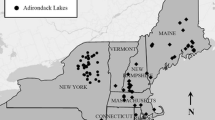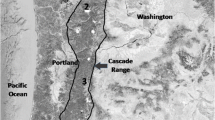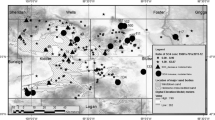Abstract
Trends in precipitation chemistry and hydrologic and climatic data were examined as drivers of long-term changes in the chemical composition of high-elevation lakes in three wilderness areas in Colorado during 1985–2008. Sulfate concentrations in precipitation decreased at a rate of −0.15 to −0.55 μeq/l/year at 10 high-elevation National Atmospheric Deposition Program stations in the state during 1987–2008 reflecting regional reductions in SO2 emissions. In lakes where sulfate is primarily derived from atmospheric inputs, sulfate concentrations also decreased although the rates generally were less, ranging from −0.12 to −0.27 μeq/l/year. The similarity in timing and sulfur isotopic data support the hypothesis that decreases in atmospheric deposition are driving the response of high-elevation lakes in some areas of the state. By contrast, in lakes where sulfate is derived primarily from watershed weathering sources, sulfate concentrations showed sharp increases during 1985–2008. Analysis of long-term climate records indicates that annual air temperatures have increased between 0.45 and 0.93°C per decade throughout most mountainous areas of Colorado, suggesting climate as a factor. Isotopic data reveal that sulfate in these lakes is largely derived from pyrite, which may indicate climate warming is preferentially affecting the rate of pyrite weathering.






Similar content being viewed by others
References
Aulenbach BT, Hooper RP, Bricker OP (1997) Trends in precipitation and surface-water chemistry in a national network of small watersheds. In: Peters NE, Bricker OP, Kennedy MM (eds) Water quality trends and geochemical mass balances, advances in hydrological processes. Wiley, London, pp 27–57
Barker F (1969) Precambrian geology of the Needle Mountains, southwestern Colorado. U.S. Geological Survey Professional Paper 644–A
Baron JS (2006) Hindcasting nitrogen deposition to determine an ecological critical load. Ecol Appl 16(2):433–439
Baron J, Denning AS (1993) The influence of mountain meteorology on precipitation chemistry at low and high elevations of the Colorado Front Range, USA. Atmos Environ 27A:2337–2349
Baron JS, Rueth HM, Wolfe AM et al (2000) Ecosystem responses to nitrogen deposition in the Colorado Front Range. Ecosystems 3:352–368
Baron JS, Schmidt TM, Harman MD (2009) Climate-induced changes in high-elevation stream nitrate dynamics. Global Change Biol 15(7):1777–1789
Blett T, Geiser L, Porter E (2003) Air pollution-related lichen monitoring in national parks, forests, and refuges: guidelines for studies intended for regulatory and management purposes. NPS D2292, National Park Service. Air Resources Division, Denver, Colorado
Bove DJ, Mast MA, Dalton JB et al (2007) Major styles of mineralization and hydrothermal alteration and related solid- and aqueous-phase geochemical signatures. U.S. Geological Survey Professional Paper 1651, Chapter E3
Bowman WD, Gartner JR, Holland K et al (2006) Nitrogen critical load for alpine vegetation and terrestrial ecosystem response: are we there yet? Ecol Appl 16:1183–1193
Bradley RS, Keimig FT, Diaz HF (2004) Projected temperature changes along the American cordillera and the planned GCOS network. Geophys Res Lett 31:L16210
Bradley RS, Vuille M, Diaz HF et al (2006) Threats to water supplies in the tropical Andes. Science 312:1755–1756
Brown GH (2002) Glacier meltwater hydrochemistry. Appl Geochem 17:855–883
Burns DA (2004) The effects of atmospheric nitrogen deposition in the Rocky Mountains of Colorado and southern Wyoming, USA—a critical review. Environ Pollut 127:257–269
Burns DA, McHale MR, Driscoll CT et al (2006) Response of surface water chemistry to reduced levels of acid precipitation: comparison of trends in two regions of New York, USA. Hydrol Process 20:1611–1627
Campbell DH, Clow DW, Ingersoll GP et al (1995) Processes controlling the chemistry of two snowmelt-dominated streams in the Rocky Mountains. Water Resour Res 31(11):2811–2821
Campbell DH, Baron JS, Tonnessen K et al (2000) Controls on nitrogen flux in alpine-subalpine watersheds. Water Resour Res 36(11):37–48
Clow DW (2010) Changes in the timing of snowmelt and streamflow in Colorado: a response to recent warming. J Clim 23(9):2293–2306. doi:10.1175/2009JCLI2951.1
Clow DW, Sickman JO, Striegl RG et al (2003a) Changes in the chemistry of lakes and precipitation in high-elevation national parks in the western United States, 1985–1999. Water Resour Res 39(6):1171. doi:10.1029/2002WR001533
Clow DW, Schrott L, Webb RM et al (2003b) Groundwater occurrence and contributions to streamflow in an alpine catchment, Colorado Front Range, USA. Ground Water 41(7):937–950
Doesken NJ, Pielke RA Sr (2003) The Drought of 2002 in Colorado. Colorado State University, Fort Collins, Colorado 14th conference on applied climatology. http://ams.confex.com/ams/pdfpapers/72906.pdf
Driscoll CT, Driscoll KM, Roy KM et al (2003) Chemical response of lakes in the Adirondack region of New York to declines in acidic deposition. Environ Sci Technol 37:2036–2042
Eimers MC, Watmough SA, Buttle JM et al (2007) Drought-induced sulphate release from a wetland in south-central Ontario. J Environ Monit Assess 127(1–3):399–407
Ford J, Stoddard JL, Powers CF (1993) Perspectives on environmental monitoring: an introduction to the U.S. EPA Long-Term Monitoring (LTM) Project. Water Air Soil Pollut 67(3–4):247–255
Forstner U, Salomons W (1988) Environmental management of solid waste. Springer-Verlag, Berlin Heidelberg
Helsel DR, Frans LM (2006) Regional Kendall test for trend. Environ Sci Technol 40(13):4066–4073
Helsel DR, Hirsch RM (1992) Statistical methods in water resources. Elsevier, Amsterdam, The Netherlands
Hill KR (2008) Potential climate impacts on hydrochemistry, source waters, and flow paths in two alpine catchments, Green Lakes Valley, Colorado: Master’s Thesis, University of Colorado, Boulder
Kahl JS, Stoddard JL, Haeuber R et al (2004) Have U.S. surface waters responded to the 1990 Clean Air Act amendments? Environ Sci Technol 38(24):484A–490A
Koinig KA, Schmidt R, Sommaruga-Wögrath S et al (1998) Climate change as the primary cause for pH shifts in a high alpine lake. Water Air Soil Pollut 104:167–180
Lafreniere M, Sharp M (2005) A comparison of solute fluxes and sources from glacial and non-glacial catchments over contrasting melt seasons. Hydrol Process 19(15):2991–3012
Laudon L, Dillon PJ, Eimers MC et al (2004) Climate-induced episodic acidification of streams in central Ontario. Environ Sci Technol 38:6009–6015
Lehmann C, Latysh N, Furiness C (2004) Discontinuation of support for field chemistry measurements in the National Atmospheric Deposition Program/National Trends Network. National Atmospheric Deposition Program Data Report 2004-02. http://bqs.usgs.gov/precip/field_chemistry_report.pdf. Accessed 1 Oct 2009
Lehmann CM, Bowersox C, Larson RS et al (2007) Monitoring long-term trends in sulfate and ammonium in US precipitation: results from the National Atmospheric Deposition Program/National Trends Network. Water Air Soil Pollut Focus 7:59–66
Manning AH, Verplanck PL, Mast MA, et al (2008) Hydrogeochemical investigation of the standard mine vicinity, Upper Elk Creek Basin, Colorado. U.S. Geological Survey Scientific Investigations Report 2007–5265
Mast MA, Turk JT, Ingersoll GI et al (2001) Variation in the sulfur isotopic composition of snowpack sulfate in the Rocky Mountains. Atmos Environ 35:3303–3313
Mast MA, Campbell DH, Ingersoll GP (2005) Effects of emission reductions at the Hayden powerplant on precipitation, snowpack, and surface-water chemistry in the Mount Zirkel Wilderness Area, Colorado, 1995–2003. U.S. Geological Survey Scientific Investigations Report 2005-5167
Millar CI, Westfall RD (2008) Rock glaciers and related periglacial landforms in the Sierra Nevada, CA, USA; inventory, distribution and climatic relationships. Quat Intern 188:90–104
Mosello R, Lami A, Marchetto A et al (2002) Trends in the water chemistry of high altitude lakes in Europe. Water Air Soil Pollut Focus 2:75–89
Murdoch PS, Burns DA, Lawrence GB (1998) Relation of climate change to acidification of surface waters by nitrogen deposition. Environ Sci Technol 32:1642–1647
Nilles MA, Conley BE (2001) Changes in the chemistry of precipitation in the United States, 1981–1998. Water Air Soil Pollut 130:409–414
Nordstrom DK (2009) Acid rock drainage and climate change. J Geochem Explor 10:97–104
Nordstrom DK, Wright WG, Mast MA, et al (2007) Aqueous-sulfate stable isotopes—A study of mining-affected and undisturbed acidic drainage. U.S. Geological Survey Professional Paper 1651, Chapter E8
Parker BR, Vinebrooke RD, Schindler DW (2008) Recent climate extremes alter alpine lake ecosystems. PNAS 105(35):12929
Plumlee GS (1999) The environmental geology of mineral deposits. In: Plumlee GS, Logsdon MJ (eds) The environmental geochemistry of mineral deposits part A: processes, techniques and health issues, reviews in economic geology, vol 6B. Society of Economic Geologists, Littleton, pp 71–116
Ray AJ, Barsugli JJ, Averyt KB et al (2008) Climate change in Colorado. A synthesis to support water resources management and adaptation for the Colorado Water Conservation Board, Western Water Assessment
Rebetez M, Reinhard M (2007) Monthly air temperature trends in Switzerland 1901–2000 and 1975–2004. Theor Appl Climatol 91:27–34
Rogora M, Mosello R, Arisci S (2003) The effect of climate warming on the hydrochemistry of alpine lakes. Water Air Soil Pollut 148:347–361
Shapiro B, Simpson HJ, Griffin KL et al (2007) Precipitation chloride at West Point, NY: seasonal patterns and possible contributions from non-seawater sources. Atmos Environ 41(10):2240–2254
Sickman JO, Melack JM, Stoddard JS (2002) Regional analysis of inorganic nitrogen yield and retention in high-elevation ecosystems of the Sierra Nevada and Rocky Mountains. Biogeochemistry 57(1):341–374
Sommaruga-Wögrath S, Koinig K, Schmidt R et al (1997) Temperature effects on the acidity of remote alpine lakes. Nature 387:64–67
Steven TA, Schmitt LJ Jr, Sheridan MJ et al (1969) Mineral resources of the San Juan primitive area, Colorado, with a section on iron resources in the Irving Formation. U.S. Geological Survey Bulletin 1261-F
Stoddard JL, Kahl JS, Deviney FA et al (2003) Response of surface water chemistry to the clean air act amendments of 1990. USEPA, Research Triangle Park, EPA/620/R-03/001NC
Sueker JK, Clow DW, Ryan JN et al (2001) Effect of basin physical characteristics on solute fluxes in nine alpine/subalpine basins, Colorado, USA. Hydrol Process 15:2749–2769
Tait D, Thaler B (2000) Atmospheric deposition and lake chemistry trends at a high mountain site in the eastern Alps. J Limnol 59:61–71
Thies H, Nickus U, Mair V et al (2007) Unexpected response of high Alpine Lake waters to climate warming. Environ Sci Technol 41(21):7424–7429
Turk JT, Adams DB (1983) Sensitivity to acidification of lakes in the Flat Tops Wilderness Area, Colorado. Water Resour Res 19(2):346–350
Turk JT, Campbell DH (1987) Estimates of acidification of lakes in the Mount Zirkel Wilderness Area, Colorado. Water Resour Res 23(9):1757–1761
Turk JT, Campbell DH (1997) Are aquatic resources of the Mt. Zirkel Wilderness Area in Colorado affected by acid deposition and what will emissions reductions at the local power plants do? U.S. Geological Survey Fact Sheet 043-97
Turk JT, Campbell DH, Spahr NE (1993) Use of chemistry and stable sulfur isotopes to determine sources of trends in sulfate of Colorado lakes. Water Air Soil Pollut 67:415–431
Watmough SA, Eimers MC, Aherne J et al (2004) Climate effects on stream nitrate at 16 forested catchments in south central Ontario. Environ Sci Technol 38:2383–2388
White AF, Schulz MJ, Lowenstern JB (2005) The ubiquitous nature of accessory calcite in granitoid rocks: implications for weathering, solute evolution, and petrogenesis. Geochim Cosmochim Acta 69(6):1455–1471
Williams M, Tonnessen K (2000) Critical loads for inorganic nitrogen deposition in the Colorado Front Range, USA. Ecol Appl 10(6):1648–1665
Williams MW, Baron JS, Caine N et al (1996) Nitrogen saturation in the Rocky Mountains. Environ Sci Technol 30(2):540–646
Williams MW, Knauf M, Caine N et al (2006) Geochemistry and source waters of rock glacier outflow, Colorado Front Range. Perma Periglac Process 17:13–33
Wolfe AP, Van Gorp AC, Baron JS (2003) Recent ecological and biogeochemical changes in alpine lakes of Rocky Mountain National Park: a response to anthropogenic nitrogen deposition. Geobiology 1:153–168
Acknowledgements
Primary support for the project came from the USDA Forest Service Region 2, the Colorado Department of Public Health and Environment, and the U.S. Geological Survey Coop Program. The authors are grateful to the numerous U.S. Geological Survey employees, contractors, students, and volunteers who worked long hours in often challenging weather conditions to maintain the long-term water-quality records at the study lakes. We thank D. Burns and G. Wetherbee for providing helpful comments on an earlier version of the manuscript.
Author information
Authors and Affiliations
Corresponding author
Additional information
John T. Turk—retired from U.S. Geological Survey.
Rights and permissions
About this article
Cite this article
Mast, M.A., Turk, J.T., Clow, D.W. et al. Response of lake chemistry to changes in atmospheric deposition and climate in three high-elevation wilderness areas of Colorado. Biogeochemistry 103, 27–43 (2011). https://doi.org/10.1007/s10533-010-9443-4
Received:
Accepted:
Published:
Issue Date:
DOI: https://doi.org/10.1007/s10533-010-9443-4




